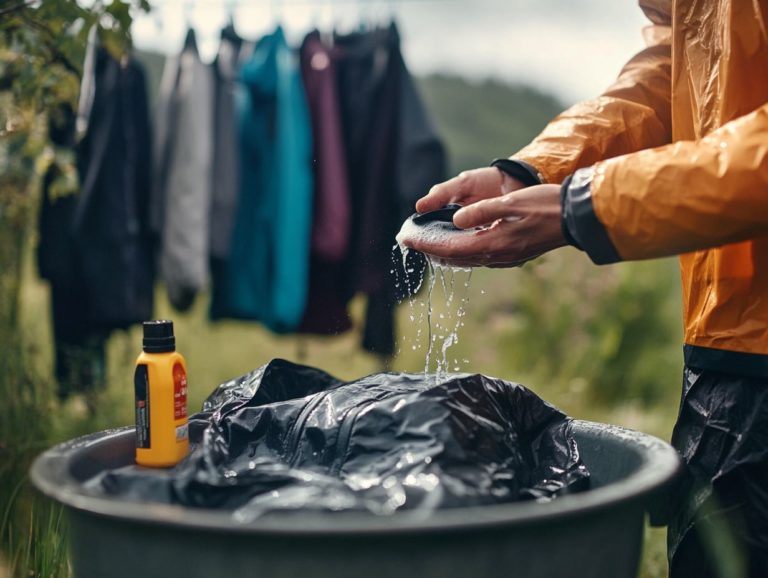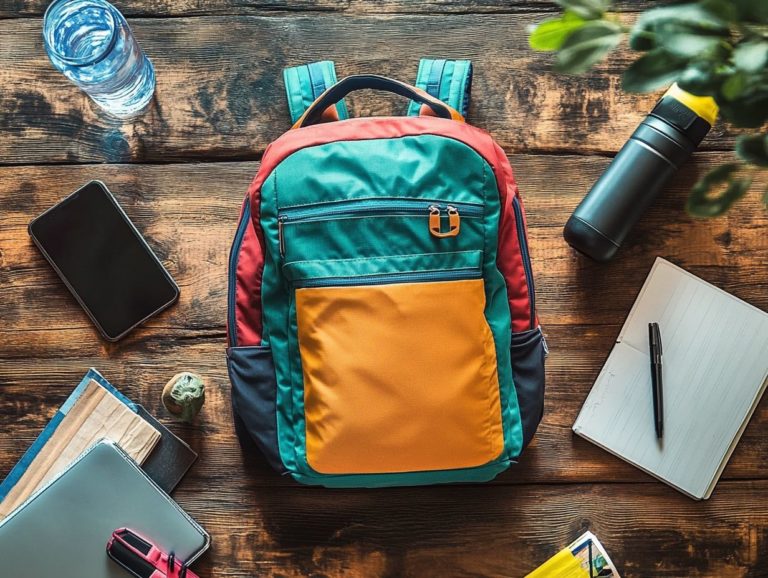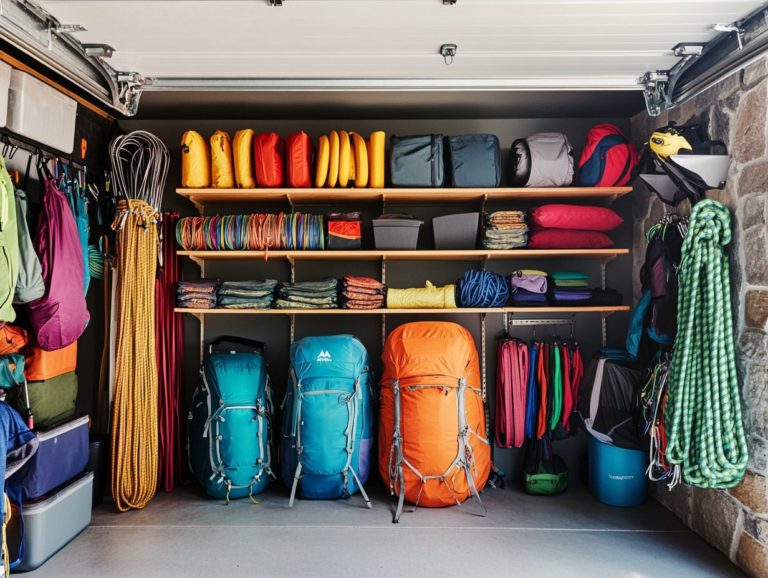What Should Be Included in Your Fishing Gear?
Fishing is more than just a hobby; it s an exhilarating adventure that hinges on having the right equipment to maximize every outing.
Whether you re a seasoned angler or just dipping your toes into the waters, understanding the essentials of fishing gear is vital for your success. Get ready to discover the must-have gear that will transform your fishing experience! This guide covers rods, reels, tackle, bait, and specialized gear tailored for various styles such as fly fishing, ice fishing, and saltwater fishing.
You will learn how to select the right gear to suit your needs and receive expert tips on maintaining and replacing your equipment. This ensures that every time you hit the water, it s nothing short of exceptional.
Dive in and discover what you need for your next fishing adventure!
Contents
Key Takeaways:
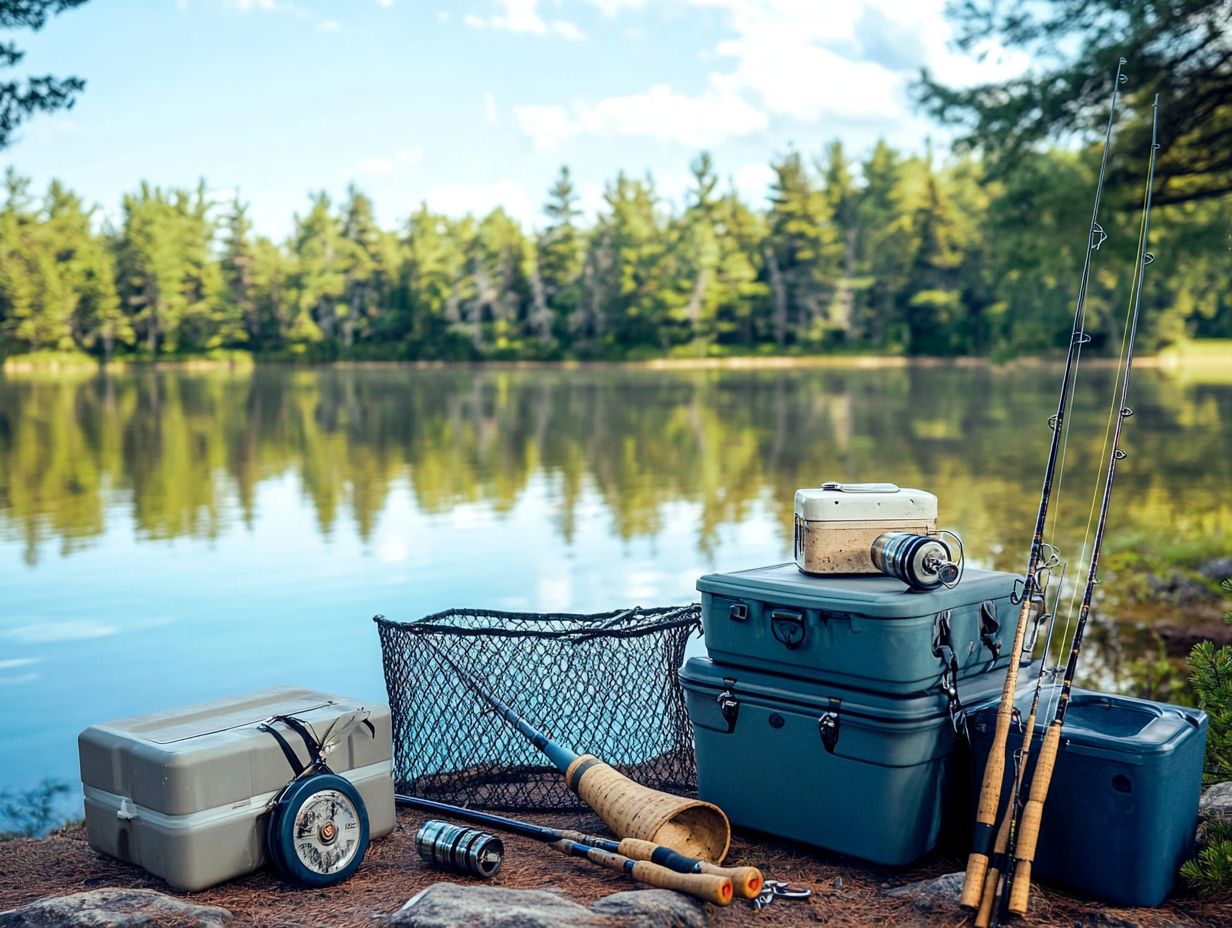
- Invest in a quality rod and reel to build a strong foundation for your fishing gear.
- Consider the type of fishing you will be doing and choose the appropriate gear, whether it s fly fishing equipment or saltwater gear.
- Maintain and regularly replace your gear to prolong its lifespan and ensure optimal performance.
Essential Fishing Gear
When you set off on a fishing adventure, especially as a first-time angler in Pennsylvania, it’s vital to arm yourself with essential gear that can greatly enhance your chances of success. This means thoughtfully choosing a quality rod and reel.
It’s also important to understand the different types of fishing tackle needed for various species, such as Largemouth bass, and the crucial role of bait and accessories.
Insights from experts like Steve Meiser can illuminate your path, helping you make informed choices that ensure you’re well-prepared for a rewarding experience on the water.
Rod and Reel
Choosing the right rod and reel is crucial for your success as an angler. These tools can greatly influence how far you can throw your line and overall fishing outcomes. If you re just starting out, consider a medium action rod paired with a reliable baitcasting reel like the Ugly Stik GX2.
This combination provides the versatility you need to target a range of species, including Largemouth bass. It offers excellent sensitivity and control, adapting seamlessly to various fishing environments, whether you’re casting in a tranquil lake or along a lively riverbank.
If you prefer something more user-friendly, spinning reels are perfect for beginners and can handle lighter lines easily. For those venturing into saltwater fishing, an offshore rod built to endure the challenges of larger catches is essential.
When selecting your rod and reel, think about the species you dream of catching; specific setups can enhance techniques like jigging or trolling. As a general guideline, beginners should choose gear that feels comfortable in their hands, allowing them to focus on the joy of fishing.
Tackle and Bait
The selection of fishing tackle and bait is crucial for attracting fish. Understanding the various options available can significantly elevate your fishing experience. As a beginner, you might want to start with live bait or soft plastics, like the reliable Gamakatsu hooks or Yamamoto Senko, which have a proven track record for enticing Largemouth bass.
Along with these well-known brands, consider exploring Comal Tackle Company, which provides high-quality soft plastics that seasoned anglers swear by. The right bait can depend on the specific environment, whether you’re fishing in freshwater lakes or along coastal waters.
For example, live bait such as minnows or worms can be particularly effective in murky waters, drawing in various fish. To maximize your chances of success, match the bait size with the target fish species and consider local conditions like water temperature and clarity. This thoughtful approach can significantly enhance your likelihood of landing a fruitful catch.
Understanding Fishing Lines
Selecting the right fishing line is crucial for ensuring optimal performance and success in your fishing pursuits. Understanding the distinctions between braided lines, such as Spiderwire, and monofilament lines like Berkley Trilene XL can significantly enhance your fishing experience.
Each type of line has unique advantages and disadvantages that can affect casting distance, sensitivity to bites, and overall catch rates. Braided lines are known for their impressive strength and resistance to abrasion. This makes them ideal for navigating heavy cover. Monofilament lines, on the other hand, offer great stretch, which helps absorb sudden pulls from fish.
When selecting a line, consider specific fishing conditions like water clarity and structure as well as your personal preferences, such as ease of use and budget. This thoughtful approach will elevate your fishing effectiveness and ensure that you make the most out of every outing.
Essential Accessories
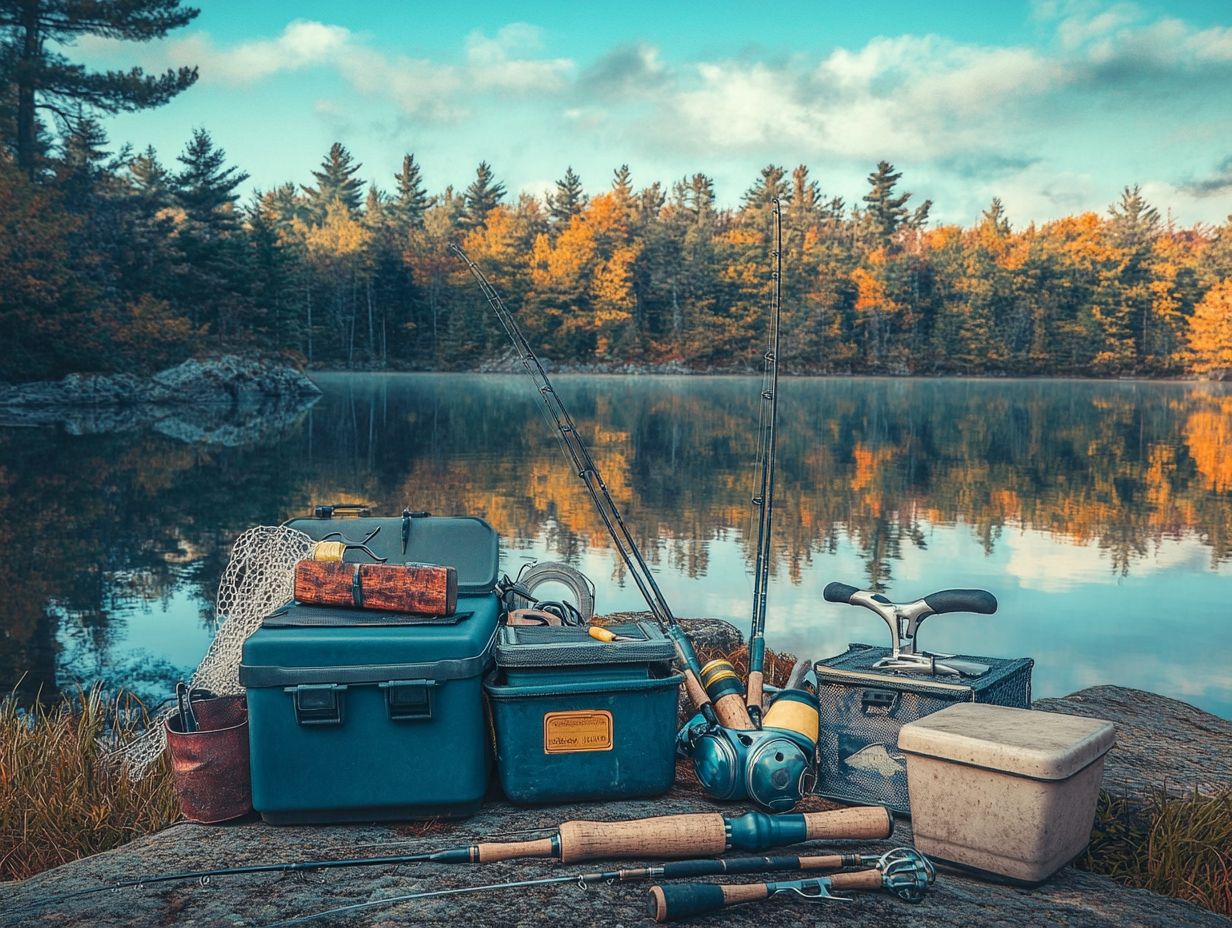
Equipping yourself with the right tools and accessories can elevate your fishing experience. A well-stocked tackle box paired with advanced gadgets like a fish finder, such as the Garmin STRIKER 4, or a solar generator like Jackery s SolarSaga 200W are game-changers for your fishing trips!
These essentials enhance accessibility and allow you to spend more time fishing instead of rummaging through disorganized gear. A tackle box like the Plano 3700 series offers customizable compartments for various lures and baits, making it easy to find exactly what you need.
If you’re looking for a comprehensive fishing experience, consider products like the Lowrance Hook Reveal. This tool can significantly improve your ability to locate fish in diverse environments, whether you re on a serene freshwater lake or navigating saltwater coastlines. With a solar generator, you can keep your devices powered all day, extending the joy of your outdoor adventures.
Additional Gear for Specific Types of Fishing
When you expand your fishing repertoire, consider additional gear tailored for various fishing styles, such as fly fishing, ice fishing, or saltwater fishing.
Each of these methods demands specialized equipment and tactics to effectively target the species in their unique environments. Investing in the right gear boosts your fishing experience and success.
Fly Fishing
Fly fishing is a captivating method involving artificial flies to entice fish. It requires specialized gear and refined casting techniques for optimal results. As a beginner, you must understand the significance of the various types of flies and cultivate your casting skills to effectively present your offerings.
Immerse yourself in the diverse array of flies available such as dry flies, nymphs, and streamers that mimic the natural diet of fish. Choosing the right rod and reel can elevate your fishing experience, as different setups suit various environments and targeted species.
Mastering casting techniques, from straightforward overhead casts to sophisticated roll casts, is vital for enhancing your success on the water. Engaging with these aspects of fly fishing sharpens your proficiency and deepens your connection with the natural world around you.
Get ready to transform your fishing adventures today!
Ice Fishing
Ice fishing presents an exhilarating way for you to enjoy the sport during the colder months. It demands special gear such as an ice auger, shelters, and tip-ups to guarantee a successful outing.
As a beginner, grasping the fundamentals of ice fishing gear and techniques can transform your experiences on frozen lakes and rivers into rewarding adventures. To embark on this exciting journey, you should start with a reliable ice auger, which is vital for drilling holes through thick ice. Investing in a quality shelter provides much-needed protection from the harsh winter elements, allowing you to fully appreciate the experience.
Tip-ups are essential for your ice fishing excursions, as they enable you to catch fish while you attend to other tasks. By embracing effective techniques like jigging, which is a method where you move bait up and down to attract fish, and familiarizing yourself with fish behavior, you ll boost your catch rates and enjoy every moment on the ice!
Always prioritize safety: check the ice thickness, wear appropriate clothing, and carry essential safety equipment to ensure a secure and enjoyable outing.
Saltwater Fishing
Saltwater fishing offers a blend of unique challenges and enticing opportunities, demanding specialized gear and tackle that cater to the diverse species inhabiting ocean environments. As a beginner, it s crucial to familiarize yourself with the specific requirements of this type of fishing to ensure you re fully prepared for your angling adventures.
To embark on this thrilling journey, a sturdy rod and reel setup is essential, often crafted from corrosion-resistant materials to endure salt exposure. You ll find that spinning reels or baitcasting options are popular choices, depending on your personal preference and experience level.
Regarding bait, consider shrimp, crabs, and cut bait, which can be particularly effective for species like snapper and flounder. Employing techniques such as bottom fishing and trolling can significantly enhance your chances of landing larger catches, such as tuna or marlin.
Understanding tides and local fishing regulations can greatly improve your chances of success. Seek guidance from experienced anglers or local fishing guides to navigate this exciting realm effectively.
Choosing the Right Gear for Your Needs
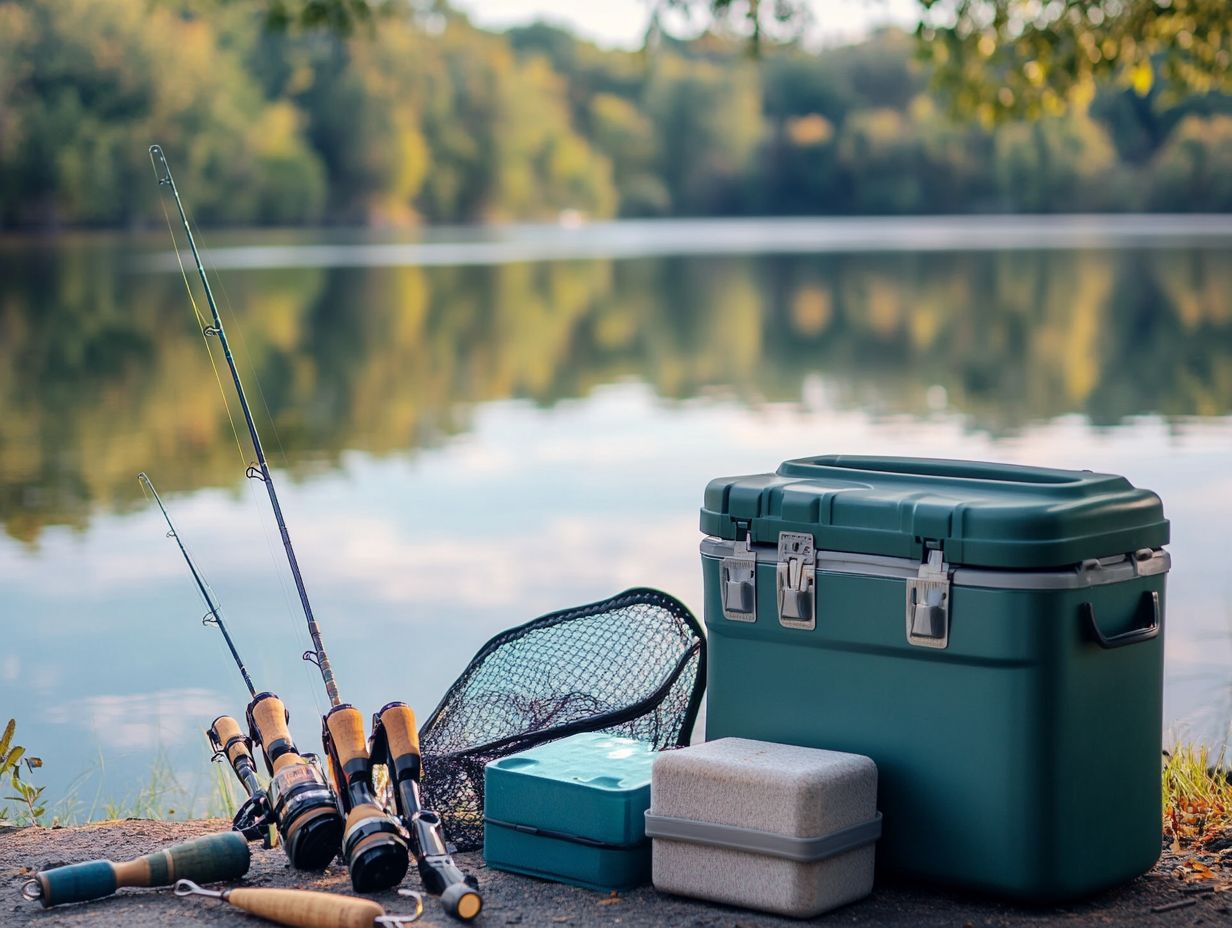
Choosing the right fishing gear tailored to your unique needs is essential for both new anglers and experienced anglers. Your personal preferences and specific fishing styles play a significant role in determining the effectiveness of your equipment.
By comprehensively understanding the various options available and how they align with your fishing goals, you will be empowered to make informed decisions that elevate your overall fishing experience.
Factors to Consider
When selecting fishing gear, it s essential to consider a few key factors: your budget, experience level, and the species you intend to target. Understanding these elements will enable you to choose the most suitable gear for your fishing excursions, whether you re just starting or have years of experience under your belt.
-
First and foremost, review your budget carefully. This will help you discern the quality and type of gear that aligns with your financial plans, ensuring that your investments are wise and won t leave you financially stranded.
-
Next, reflect on your skill level. As a novice, you might find greater benefit from simpler, user-friendly equipment that enhances your learning curve. On the other hand, if you re a seasoned angler, you may be in the market for advanced tools that provide the precision and performance you crave.
-
Identifying the species you wish to target is another critical step, as different fish necessitate specific tackle and techniques. For beginners, focusing on versatile, all-purpose gear can significantly increase your chances of success, allowing you to gradually refine your choices as you build your expertise.
Maintaining and Replacing Your Fishing Gear
Maintain your fishing gear to ensure it lasts longer and performs better. Clean your rod and reel, and inspect your tackle regularly to keep your equipment reliable.
Embracing these key care tips will not only elevate your fishing experience but also ensure that your gear remains in top-notch condition for many adventures to come.
Tips for Proper Care
To keep your fishing gear in peak condition, implement proper care techniques, which include routine cleaning and suitable storage solutions. By adopting these practices, you enhance the performance and longevity of your equipment, ensuring you’re always prepared for your next fishing adventure.
Regularly rinsing your rods and reels with fresh water after each outing prevents salt and dirt buildup, which is essential for maintaining functionality. For your fishing lines, a gentle wipe-down can remove debris, ensuring a smooth casting experience.
Don t overlook seasonal maintenance; apply oil or grease to your reels and inspect rod guides for any damage to avoid unexpected failures while you re out on the water. Store your gear in a cool, dry location, ideally in protective cases, to reduce wear and tear.
This not only shields your items from humidity but also protects them from UV rays that can degrade materials over time.
Frequently Asked Questions
What should be included in my fishing gear?
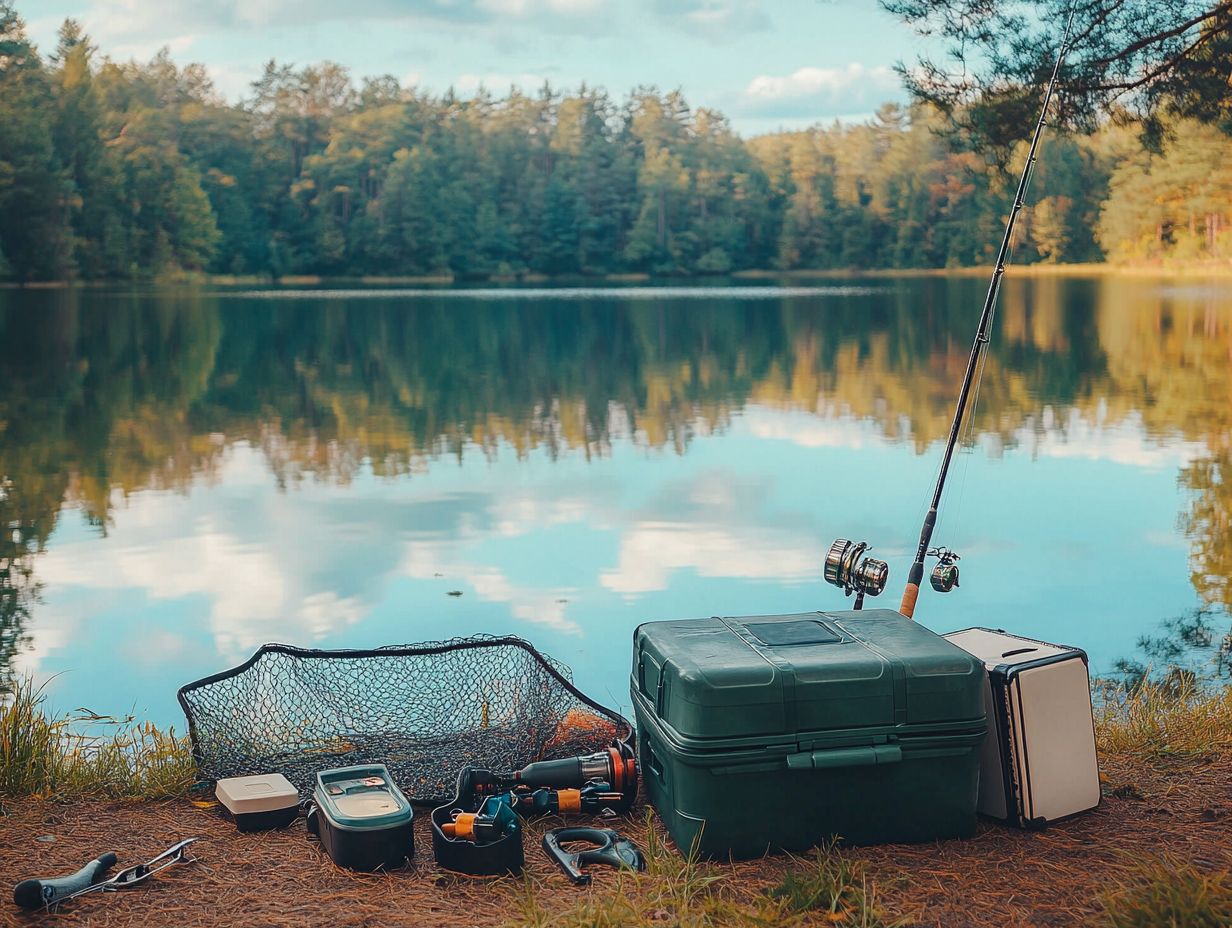
Your fishing gear should include a fishing rod, reel, fishing line, hooks, bait, sinkers, and a tackle box.
Do I need any specific type of fishing gear?
The type of fishing gear you need will depend on the type of fishing you plan to do. For instance, if you’re fishing in freshwater, you may need different gear than if you’re fishing in saltwater.
Why is it important to have a tackle box?
A tackle box is important because it keeps all of your gear organized and easily accessible. It also helps protect your gear from damage.
What type of bait should I include in my fishing gear?
The type of bait you should include in your fishing gear will depend on the type of fish you’re trying to catch. Common types of bait include worms, minnows, and artificial lures.
Is it necessary to have multiple fishing rods?
Having multiple fishing rods can be beneficial, especially if you plan on fishing in different types of environments or targeting different types of fish. However, if you’re just starting out, one fishing rod is sufficient.
What other items should I consider including in my fishing gear?
Consider including a fishing net, pliers, and a first-aid kit in your fishing gear. These can come in handy for various situations while out on the water.
Start maintaining your fishing gear today, and get ready for your best fishing trip ever!
With the right care, your adventures on the water will be unforgettable!



